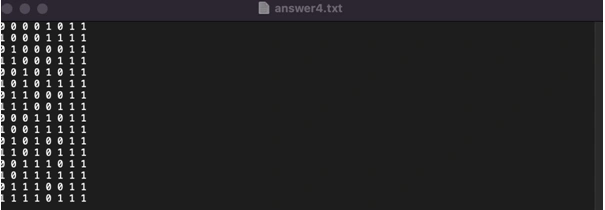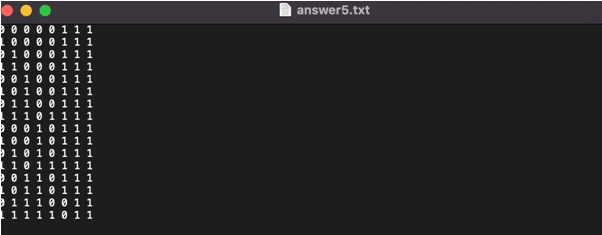Instructions
Requirements and Specifications
- The first line of the file will look like this: "INPUTVAR 2 input0 input1". The number N indicates the number of Boolean input variables to the digital logic circuit. In this case N=2. The rest of the line lists the names of the input variables, separated by spaces.
- The second line of the file will look like this: "OUTPUTVAR 1 output0". The number M indicates the number of Boolean output variables from the digital logic circuit. In this case M=1. The rest of line lists the names of the output variables, separated by spaces.
- The remainder of the file will have lines describing digital logic gates. The gates have either a single input or two inputs:
- Single input gates include the "NOT" gate. A line describing such a gate will look like this: "NOT input0 temp0". This means the Boolean value of temp0 = ! input0. The intermediate Boolean variable temp0 is a variable in the circuit that is neither part of the inputs nor outputs of the digital circuit, but you need to keep track of temp0's value to calculate the circuit's truth table.
- Double input gates include the "AND", "NAND", "OR", "NOR", "XOR", and "XNOR" gates. A line describing such a gate will like this: "XNOR input1 temp0 output0". This means the Boolean value of output0 = input1 XNOR temp0.
- Instead of double input gates, the input files now have multi-input gates that include the "AND", "NAND", "OR", and "NOR" gates. A line describing such a gate will like this: "AND 3 input1 input0 input1 temp0". The second entry on the line indicates that this AND gate takes three inputs, which are immediately listed before listing the single output variable. This means the Boolean value of temp0 = input1 AND input0 AND input1.
- The input files will no longer have "XOR" and "XNOR" gates as these gates do not have a strict definition for multiple inputs.






Source Code
Basic Gates
#!/usr/bin/python3
import os
import datetime
import random
import subprocess
def generate_test ( filenum, inCount=1, gateCount=0, outCount=1, path="./" ):
inVars = [ "input"+str(i) for i in range(inCount) ]
gates = ("NOT", "AND", "NAND", "OR", "NOR", "XOR", "XNOR")
tempCount = 0
tempVars = inVars.copy()
circuit = []
outVars = []
for i in range(gateCount):
in0 = random.choice(tempVars)
in1 = random.choice(tempVars)
gate = random.choice(gates)
out = "temp"+str(tempCount)
tempCount += 1
circuit.append({ "in0":in0, "in1":in1, "gate":gate, "out":out })
tempVars.append(out)
for i in range(outCount):
in0 = random.choice(tempVars)
in1 = random.choice(tempVars)
gate = random.choice(gates)
out = "output"+str(i)
circuit.append({ "in0":in0, "in1":in1, "gate":gate, "out":out })
outVars.append(out)
with open("{}tests/test{}.txt".format(path,filenum), "w") as infile:
infile.write("INPUTVAR {}".format(inCount))
for inVar in inVars:
infile.write(" "+inVar)
infile.write("\n")
infile.write("OUTPUTVAR {}".format(outCount))
for outVar in outVars:
infile.write(" "+outVar)
infile.write("\n")
for gate in circuit:
if gate["gate"] is "NOT":
infile.write( "NOT {} {}\n".format( gate["in0"], gate["out"] ) )
else:
infile.write( "{} {} {} {}\n".format( gate["gate"], gate["in0"], gate["in1"], gate["out"] ) )
with open("{}answers/answer{}.txt".format(path,filenum), "w") as outfile:
for i in range(2**inCount):
state = {}
for bit, inVar in enumerate(inVars):
state[inVar] = bool(1&i>>bit)
for gate in circuit:
inState0 = state[gate["in0"]]
inState1 = state[gate["in1"]]
if gate["gate"] is "NOT":
outState = not inState0
elif gate["gate"] is "AND":
outState = inState0 and inState1
elif gate["gate"] is "NAND":
outState = not(inState0 and inState1)
elif gate["gate"] is "OR":
outState = inState0 or inState1
elif gate["gate"] is "NOR":
outState = not(inState0 or inState1)
elif gate["gate"] is "XOR":
outState = inState0!=inState1
elif gate["gate"] is "XNOR":
outState = inState0==inState1
else:
error()
state[gate["out"]] = outState
for inVar in inVars:
outfile.write("{} ".format(int(state[inVar])))
for outVar in outVars:
outfile.write("{} ".format(int(state[outVar])))
outfile.write("\n")
def generate_test_suite():
os.makedirs("tests", exist_ok=True)
os.makedirs("answers", exist_ok=True)
generate_test ( 0, inCount=1, gateCount=0, outCount=1, path="./" )
generate_test ( 1, inCount=2, gateCount=1, outCount=1, path="./" )
generate_test ( 2, inCount=2, gateCount=2, outCount=2, path="./" )
generate_test ( 3, inCount=2, gateCount=4, outCount=2, path="./" )
generate_test ( 4, inCount=4, gateCount=8, outCount=4, path="./" )
generate_test ( 5, inCount=4, gateCount=16, outCount=4, path="./" )
def test_basicGates ( filenum, path="./", verbose=False ):
try:
with open("{}answers/answer{}.txt".format(path,filenum), "r") as outfile:
answerSet = set()
for line in outfile.read().split("\n"):
row = []
for string in line.split(" "):
if string is not "":
row.append(int(string))
if line is not "":
answerSet.add(tuple(row))
except EnvironmentError: # parent of IOError, OSError
print ("answers/answer{}.txt missing".format(filenum))
try:
result = subprocess.run(
["./basicGates", "tests/test{}.txt".format(filenum)],
cwd=path,
check=True,
stdout=subprocess.PIPE,
stderr=subprocess.STDOUT,
encoding="ASCII",
timeout=datetime.timedelta(seconds=4).total_seconds(),
)
resultSet = set()
for line in result.stdout.split("\n"):
row = []
for string in line.split(" "):
if string is not "":
row.append(int(string))
if line is not "":
resultSet.add(tuple(row))
if verbose:
print (' '.join(result.args))
# print ("answer")
# print (answerSet)
# print ("result")
# print (result.stdout)
assert resultSet == answerSet, "The circuit simulation result doesn't match answers/answer{}.txt.".format(filenum)
return True
except subprocess.CalledProcessError as e:
print (e.output)
print ("Calling ./basicGates returned non-zero exit status.")
except ValueError as e:
print (result.stdout)
print ("Please check your output formatting.")
except AssertionError as e:
print (result.stdout)
print (e.args[0])
return False
def grade_basicGates( path="./", verbose=False ):
score = 0
try:
subprocess.run( ["make", "-B"], cwd=path, check=True, )
except subprocess.CalledProcessError as e:
print ("Couldn't compile basicGates.")
return score
if test_basicGates(0,path,verbose):
score += 5
if test_basicGates(1,path,verbose):
score += 5
if test_basicGates(2,path,verbose):
score += 5
if test_basicGates(3,path,verbose):
score+= 5
if test_basicGates(4,path,verbose):
score += 5
if test_basicGates(5,path,verbose):
score += 5
for filenum in range(6,16):
generate_test ( filenum, inCount=8, gateCount=16, outCount=8, path=path )
if test_basicGates(filenum,path,verbose):
score += 1
else:
break
print ("Score on basicGates: {} out of 40.".format(score))
return score
if __name__ == '__main__':
# generate_test_suite()
grade_basicGates(verbose=True)
exit()
Multi Input
#!/usr/bin/python3
import os
import datetime
import random
import subprocess
def generate_test ( filenum, circuitInCount=1, gateInMax=4, gateCount=0, circuitOutCount=1, path="./" ):
inVars = [ "input"+str(i) for i in range(circuitInCount) ]
gates = ("NOT", "AND", "NAND", "OR", "NOR")
tempCount = 0
tempVars = inVars.copy()
circuit = []
outVars = []
for i in range(gateCount):
gate = random.choice(gates)
if gate is "NOT":
gateInCount = 1
elif gate in ("AND", "NAND", "OR", "NOR"):
gateInCount = random.randint(2,gateInMax)
gateIn = random.choices(tempVars,k=gateInCount)
gateOut = "temp"+str(tempCount)
tempCount += 1
circuit.append({ "inCount":gateInCount, "gateIn":gateIn, "gate":gate, "gateOut":gateOut })
tempVars.append(gateOut)
for i in range(circuitOutCount):
gate = random.choice(gates)
if gate is "NOT":
gateInCount = 1
elif gate in ("AND", "NAND", "OR", "NOR"):
gateInCount = random.randint(2,gateInMax)
gateIn = random.choices(tempVars,k=gateInCount)
gateOut = "output"+str(i)
circuit.append({ "inCount":gateInCount, "gateIn":gateIn, "gate":gate, "gateOut":gateOut })
outVars.append(gateOut)
with open("{}tests/test{}.txt".format(path,filenum), "w") as infile:
infile.write("INPUTVAR {}".format(circuitInCount))
for inVar in inVars:
infile.write(" "+inVar)
infile.write("\n")
infile.write("OUTPUTVAR {}".format(circuitOutCount))
for outVar in outVars:
infile.write(" "+outVar)
infile.write("\n")
for gate in circuit:
if gate["gate"] is "NOT":
infile.write( "NOT {} {}\n".format( ' '.join(map(str, gate["gateIn"])), gate["gateOut"] ) )
else:
infile.write( "{} {} {} {}\n".format( gate["gate"], gate["inCount"], ' '.join(map(str, gate["gateIn"])), gate["gateOut"] ) )
with open("{}answers/answer{}.txt".format(path,filenum), "w") as outfile:
for i in range(2**circuitInCount):
state = {}
for bit, inVar in enumerate(inVars):
state[inVar] = bool(1&i>>bit)
for gate in circuit:
inStates = [ state[gateIn] for gateIn in gate["gateIn"] ]
if gate["gate"] is "NOT":
outState = not inStates[0]
elif gate["gate"] is "AND":
outState = True
for inState in inStates:
outState = outState and inState
elif gate["gate"] is "NAND":
outState = True
for inState in inStates:
outState = outState and inState
outState = not outState
elif gate["gate"] is "OR":
outState = False
for inState in inStates:
outState = outState or inState
elif gate["gate"] is "NOR":
outState = False
for inState in inStates:
outState = outState or inState
outState = not outState
else:
sys.exit("Invalid gate.")
state[gate["gateOut"]] = outState
for inVar in inVars:
outfile.write("{} ".format(int(state[inVar])))
for outVar in outVars:
outfile.write("{} ".format(int(state[outVar])))
outfile.write("\n")
def generate_test_suite():
os.makedirs("tests", exist_ok=True)
os.makedirs("answers", exist_ok=True)
generate_test ( 0, circuitInCount=1, gateInMax=2, gateCount=0, circuitOutCount=1, path="./" )
generate_test ( 1, circuitInCount=2, gateInMax=2, gateCount=1, circuitOutCount=1, path="./" )
generate_test ( 2, circuitInCount=2, gateInMax=3, gateCount=2, circuitOutCount=2, path="./" )
generate_test ( 3, circuitInCount=2, gateInMax=4, gateCount=4, circuitOutCount=2, path="./" )
generate_test ( 4, circuitInCount=4, gateInMax=5, gateCount=8, circuitOutCount=4, path="./" )
generate_test ( 5, circuitInCount=4, gateInMax=6, gateCount=16, circuitOutCount=4, path="./" )
def test_multiInput ( filenum, path="./", verbose=False ):
try:
with open("{}answers/answer{}.txt".format(path,filenum), "r") as outfile:
answerSet = set()
for line in outfile.read().split("\n"):
row = []
for string in line.split(" "):
if string is not "":
row.append(int(string))
if line is not "":
answerSet.add(tuple(row))
except EnvironmentError: # parent of IOError, OSError
print ("answers/answer{}.txt missing".format(filenum))
try:
result = subprocess.run(
["./multiInput", "tests/test{}.txt".format(filenum)],
cwd=path,
check=True,
stdout=subprocess.PIPE,
stderr=subprocess.STDOUT,
encoding="ASCII",
timeout=datetime.timedelta(seconds=4).total_seconds(),
)
resultSet = set()
for line in result.stdout.split("\n"):
row = []
for string in line.split(" "):
if string is not "":
row.append(int(string))
if line is not "":
resultSet.add(tuple(row))
if verbose:
print (' '.join(result.args))
# print ("answer")
# print (answerSet)
# print ("result")
# print (result.stdout)
assert resultSet == answerSet, "The circuit simulation result doesn't match answers/answer{}.txt.".format(filenum)
return True
except subprocess.CalledProcessError as e:
print (e.output)
print ("Calling ./multiInput returned non-zero exit status.")
except ValueError as e:
print (result.stdout)
print ("Please check your output formatting.")
except AssertionError as e:
print (result.stdout)
print (e.args[0])
return False
def grade_multiInput( path="./", verbose=False ):
score = 0
try:
subprocess.run( ["make", "-B"], cwd=path, check=True, )
except subprocess.CalledProcessError as e:
print ("Couldn't compile multiInput.")
return score
if test_multiInput(0,path,verbose):
score += 5
if test_multiInput(1,path,verbose):
score += 5
if test_multiInput(2,path,verbose):
score += 5
if test_multiInput(3,path,verbose):
score+= 5
if test_multiInput(4,path,verbose):
score += 5
if test_multiInput(5,path,verbose):
score += 5
for filenum in range(6,16):
generate_test ( filenum, circuitInCount=8, gateInMax=8, gateCount=16, circuitOutCount=8, path=path )
if test_multiInput(filenum,path,verbose):
score += 1
else:
break
print ("Score on multiInput: {} out of 0. (extra credit)".format(score))
return score
if __name__ == '__main__':
# generate_test_suite()
grade_multiInput(verbose=True)
exit()
Related Samples
Explore our collection of Python Assignments samples, which cover a range of topics including data structures, algorithms, functions, and key libraries such as NumPy and Pandas. These examples provide clear explanations and code snippets to help students excel in Python programming assignments and projects, enhancing their understanding and practical skills.
Python
Python
Python
Python
Python
Python
Python
Python
Python
Python
Python
Python
Python
Python
Python
Python
Python
Python
Python
Python
.webp)